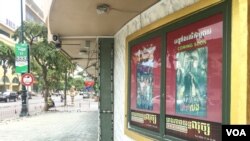When she first visited the now defunct Capitol Cinema in Phnom Penh, Hun Sokagna came up with an idea: to document Cambodia’s pre-1975 cinemas.
“The building structure was really interesting and I knew I had to do something about it,” she said.
As part of the last batch of youngsters working with the Vann Molyvann project, she launched Roung Kon, which aims to document and promote the glory days of Cambodia’s silver screen.
“We divided the project into parts, doing research on the Internet, interviewing the neighbors and those who were involved, like on-screen stars as well,” Sokagna said.
During the civil conflict which led to the Khmer Rouge taking power in 1975, watching movies was a way for people to escape the harsh reality of war, she added.
“The more panic they felt, the more they wanted to watch.”
The Roung Kon project team found 33 cinemas that were operating prior to 1975, says Hor Daro, another member of the group. “That’s why it motivates us even more,” he says.
Meanwhile, Rin Chhoum Virak, a graduate student reading Khmer literature at the Royal University of Phnom Penh, also shares the vision of the Roung Kon project. In 2010, he joined a group called Preah Soriya, which seeks to rediscover old movies.
“I have always been a huge fan of the old Cambodian films and I started to get even more interested in talking with my aunt, who was my inspiration in the film industry,” he said.
The 22-year-old said the films of 1960s Cambodia were “considered a reflection of life and the reputation of the actors was valuable.”
Since 2015, the Preah Soriya team has uncovered 50 lost films, 10 original reel movies, and six documentaries, along with numerous film posters, vinyls, and documents.
The group organized an event, Mouy Mern Ah Lai, which hosted screenings of the films and a 1960s fashion displayed, earlier this month.
Amid this surge in interest in among Cambodian youth, the last of the cinemas to remain in use, Lux Cinema, is scheduled to be renovated and transformed into a co-working space.
Competition from modern cinemas showing the latest big-budget movies from Asia and Hollywood drove Lux out of business, said Pok Borak, acting director of the Ministry of Culture’s cinema and cultural diffusion department.
“The Lux cinema hall is old and now other cinemas are inside malls and it’s much more convenient for people,” he said.
“In the past, our filmmakers went through proper training and had the ability to produce good films, but now we need a lot of factors to come together to produce one good film,” he added.
For Srin Sokmean, who has for years built up an archive of Cambodian cultural artifacts on his blog, Amazing Cambodia, the Roung Kon and Preah Soriya initiatives were good news.
“They know what it is and how valuable and precious those documents are, and I’m more than glad to hear that the younger Cambodians make efforts to do this,” Sokmean said.
Sokmean hopes that Cambodia’s cinemas can be preserved as tourist attractions. “It would be beneficial for our country to open them as tourist sites so visitors can get an eye-opening experience seeing all the amazing architecture,” he said.
“I want to see development and preservation on the same page.”









